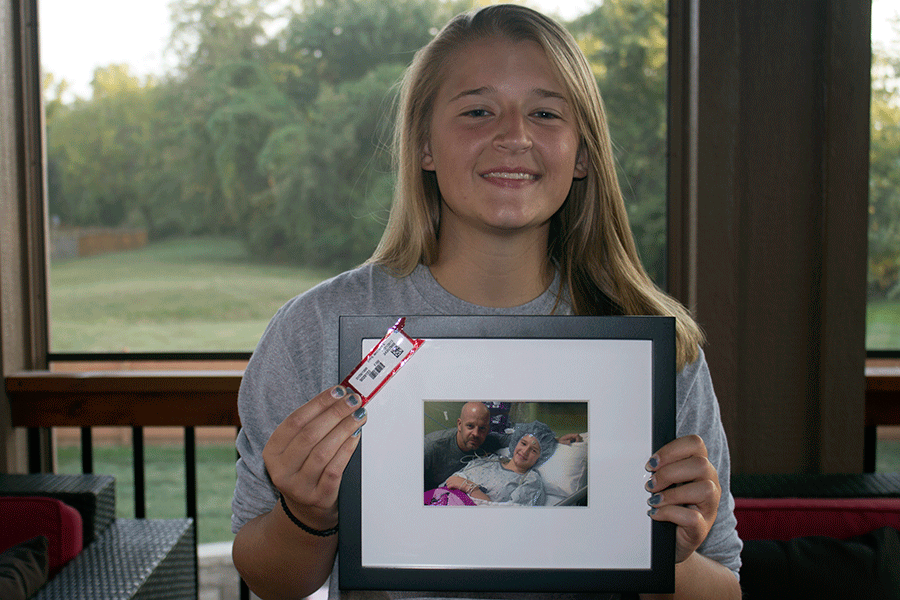Sitting in her home, senior Whitney Epps displays a photo taken after her 12 hour brain surgery. “I was very loopy during the operation, but I knew what was going on,” Epps said. “It felt pretty weird, but I think it was kind of cool.”
Senior Whitney Epps undergoes brain surgery to remove seizure-causing lesion
After struggling with seizures since 2011, Epps reflects on lessons learned
Squeezing a nearby nurse’s hand, senior Whitney Epps counted backwards from 10, all while surgeons carefully removed a seizure-causing lesion from her brain.
Whitney first noticed symptoms of the seizures in seventh grade. Initially, only her face was affected, occasionally clenching up and going numb. By freshman year, she experienced fully developed seizures in which the right side of her body would go completely numb and begin to twitch, leaving her unable to move for 1-2 minutes.
Due to Whitney being diagnosed with Tourette’s syndrome and attention deficit hyperactive disorder earlier in life, her family originally believed the seizures may have been side effects of these conditions. As the seizures progressively worsened, the family decided to look into other possibilities.
“Finally, we just came to the conclusion that it wasn’t the Tourette’s causing [the seizures],” Whitney’s mother, Angela Epps, said. “It had to be something else. That’s when we looked down the road to neurology.”
In December 2012, during an MRI at Children’s Mercy Hospital, it was discovered that Whitney had a lesion on the right side of her brain, called a cavernous hemangioma. The doctors believed the lesion had been with Whitney her whole life, but only began agitating her once she reached adolescence.
“In the beginning, the part of her brain around the lesion wasn’t doing anything because it hadn’t grown up yet,” Angela said. “It only started affecting her once that part of the brain started working more.”
A surgery was scheduled for March 2013 to remove it, but was later pushed back as the doctors were required to provide “proof” of the seizures through an electroencephalogram. During the fall of 2013, Whitney underwent three EEGs at St. Louis Children’s Hospital before doctors were able to record a seizure.
“They hook up all the electrodes to your head and try to get you to have a seizure so they can read the brainwaves,” Whitney said. “I would stay in there for a whole week and couldn’t leave the room because I was hooked up to everything.”
Surgery was finally scheduled for December 2013 at St. Louis Children’s. Prior to the operation, Whitney struggled with stress and anxiety stemming from the quickly approaching procedure.
“I was scared. I had never had a big surgery before, or even broken a bone,” Whitney said. “I went through a lot of emotional stuff. Sometimes I would come home from school and just cry. I had to do some counseling before [the surgery].”
Though other family members were emotionally affected by the ordeal, they provided Whitney with support and comfort.
“I was the caregiver and made sure everything got done on a certain schedule. Obviously, I comforted my daughter, but my husband was the one to talk to her about being strong because I was too worried about it,” Angela said. “He tends to make things humorous, and worked a lot with her on thinking about things in a certain way that aren’t so serious.”
Though Whitney was put on anesthesia and remained unconscious for the majority of the surgery, she was woken up for a brief time. In order to ensure various parts of Whitney’s brain still functioned correctly, the neurosurgeons asked her questions to assess how the operation affected her speech patterns.
“I was under so much anesthesia that the nurse who was holding my hand just kept asking me questions and I talked through the whole thing, which is part of the reason they did so well at knowing that they got all of [the lesion out] without damaging anything,” Whitney said. “[Talking to the doctors] gave me reassurance that I was OK.”
After surgery, Whitney spent a day recovering in the intensive care unit, but was officially discharged after three days. When school started up after winter break, Whitney took half-days for the first week and skipped seminar the second week before she went back as full-time student. Overall, the recovery process was quicker and much smoother than expected, according to Angela.
“It was crazy how well she recovered. The doctors said she was a rockstar,” Angela said. “We’re so lucky she didn’t have any speech problems or muscle weakness. It was a gold-star, textbook procedure.”
Since the operation, Whitney has had the opportunity to be more involved in school and joined the swim team her sophomore year. Additionally, she has improved academically, as the effects of the lesion no longer impair her thinking abilities.
“Freshman and sophomore year were really tough academically,” Angela said. “She didn’t have terrible grades, but it was really hard for her to get through all the work because it took so much thinking time.”
Whitney has been seizure free since November 2013, when she experienced an induced seizure through an EEG. Over the past year, she has been weaned down to the lowest dosage of anti-seizure medication, and will be able to stop taking the medicine entirely in January 2016.
“I feel like a stronger person, and I’m a lot happier now,” Whitney said. “After going through all of this, I don’t judge people, because there’s probably a reason why they are the way they are and there’s probably more to their story.”
